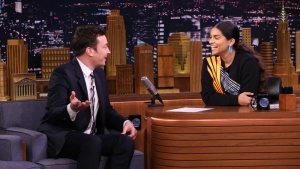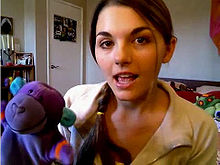Vlogging
Vlogs can be hard to characterize, and the question of whether a video is a vlog or not is subjective. In general, a video is a vlog if it follows some of these guidelines:[1]
It is a recording of the creator, provides insight into the creator's opinion or experiences, the creator is trying to build a personal connection with the audience, and the creator is talking to the camera like it is a person.
Many types of vlogs have emerged over the years as the concept has evolved, giving mainstream fame to influential creators. However, the topic remains controversial due to some ethical issues that haven arisen as vlogging has grown.
History
Creation and Evolution
The term was coined by Luuk Bowman, a musician who created a blog website featuring video diaries in 2002. [2] However, vlogs themselves have likely been around for as long as personal cameras have. Home videos or personal videos can be considered an early form of vlogging, before the term was created and integrated into popular culture. Vlogging has since become popularized in the twenty-first century, notably through the online video-sharing platform, YouTube. YouTube launched in 2005, allowing content to be viewed and shared much more easily. A creator by the name of LonelyGirl15 who rose to prominence from 2006-2008 was one of the first to popularize the now-traditional style of vlogging where the creator speaks directly to the camera as if it were a friend. Prior content that was considered "vlogging" did not necessarily include this, which has now become the mark of a vlog.
Like any Internet phenomenon, vlogging began to expand as the technology required for its creation did. As small, portable cameras developed and became both more accessible and higher quality, the vlogging community saw an expansion. Similarly, the evolution of cell phone cameras especially in the 2010s helped expand vlogging into something in which many people could partake.
Now
By 2020, vlogging has become a huge portion of YouTube. Many YouTubers have created secondary channels just for vlogs, giving their subscribers an insight into their personality and their daily lives. Further, for some people, vlogging has become a full-time job. Many YouTube channels have gained traction through only posting vlogs as well. Random chit-chat and daily vlogging has proven to be a popular, launching channels to fame in short amounts of time. A notable example is Emma Chamberlain, an 18 year old YouTube vlogger who began creating videos during July of 2017 and had amassed 150,000 subscribers in August of the same year.[3]
“Vlogging” has become a widely used term on the internet, popularized even more with the coining of a popular friend group of vloggers as "The Vlog Squad." The squad, with over 20 members, regularly produces content for their channels, and got their name from starring in their leader David Dobrik's videos. Dobrik has published 638 vlogs with them as of March 12, 2020.[4]

With the increasing popularity of vlogging, creators have started to get the chance to break into mainstream media. One avenue for this is acting in television and movies. Many vloggers take this route as their vlogs' popularity allows for increased networking and professional contacts, leading to acting jobs. Similarly, vloggers have begun to receive invitations to appear on talk shows, like David Dobrik's appearance on "The Late Night Show with Jimmy Fallon" on January 22, 2020. Other vloggers have been increasingly invited to mainstream media events such as awards shows. Recently, at the 2019 Met Gala, YouTubers Liza Koshy, James Charles, and Lilly Singh were invited, marking a victory for vloggers in mainstream media. Singh in particular has found success in this regard, as she announced on March 14, 2019 that she would begin hosting her own Late Night talk show, "A Little Late with Lilly Singh," in 2020[5].
Popular Types of Vlogs
Vlogs may be centered around a certain topic, giving the creator's opinion or facts on the matter. Alternatively, they may have no topic of informative purpose, and rather be a stream of consciousness, follow-me-around type of video. Some popular types of vlogs include: [6]
Beauty, and Fashion
As YouTube's Beauty Community has grown, beauty and fashion vlogs have become popular. These may include clothing hauls where creators show viewers some of their favorite new purchases, "get ready with me" makeup tutorial videos, and more.
Day in the Life
Another popular category which entails vloggers showing their viewers their daily routine, often with a chit-chat tone.
Product Reviews
These videos examine new or interesting products, often with the purpose of giving a recommendation for or against purchase. They may be sponsored advertisements or unsponsored, honest opinion pieces.
Travel
Travel vlogs have become popular as well, usually featuring artistic shots of influencers' vacations to exotic or interesting locations.
Ethical Concerns
Privacy
Due to the intimate nature of vlog content, many vloggers tend to share a lot of their personal information in their videos. In "Day in My Life" videos, for example, a creator may show much of their daily routine, including their home, places they frequently visit, and their friends and families. By sharing this information online, they put their own privacy at risk. One recent development in the past few years has been viewers locating and showing up to vloggers' houses. Popular vlogger David Dobrik, whose house is frequently shown in his videos, explained that this had started happening to him and begged fans in a tweet to “PLEASE STOP COMING TO MY FUCKING HOUSE.” [7] Vloggers and sisters, Rachel and Colleen Ballinger, elaborated on the issue in their podcast, saying that it triggers fear and anxiety because their home is somewhere "where [they're] supposed to feel safe."
Product Placement
With the increased popularity of vloggers, businesses have been quick to take the opportunity for marketing and brand deals. Thus, it is now common for vloggers to post "sponsored" videos in which they receive a sum of money in exchange for promotion of a product or service. However, it is not always clear when videos are sponsored and when a creator is simply conveying their honest opinion. Further, even when sponsorships are made clear, it brings up an issue of authenticity. It is hard to tell whether the creator has the viewers' best interests in mind when pushing a product, or if they truly enjoy the product themselves.
Self-Image
Problems for Vloggers
Many vloggers have opened up in recent years about struggles with various mental health and disordered eating issues as a result of their vlogging and stardom. Being on camera constantly and receiving criticism from vlog viewers can cause creators feel the need to conform to societal beauty standards. The pressure for those with large followings can then lead to the development of insecurities and body image problems. One YouTube lifestyle vlogger, Meredith Foster, revealed in a video posted on August 10, 2019 that she had struggled with body dysmorphia due to the pressures of social media brought on by her large vlog following. [8]
Problems for their Viewers
Vloggers' concerns with self image can also lead to problems for the viewers. Often, vloggers promote "healthy" practices such as diets, hacks, or workout routines. This leads viewers to believe that they need to follow these tips or to alter their own behavior in order to become like their idols, the vloggers. Frequently, the viewers do not see the full story, and just what the vloggers choose to edit into the video, so this can lead to the promotion of unhealthy behavior and goals. In Meredith Foster's video regarding her eating disorder, a viewer named Maria Alejandra Mercado commented, saying "I remember telling myself 'I wanna be skinny like Meredith,'" at a time when Meredith remembers was during the worst of her eating disorder experience.
Sensitive Content
Vloggers have creative freedom, and many post all kinds of videos. As one of the major sources of vlog content, YouTube has set community guidelines[9] in order to ensure that inappropriate content is not posted. In the past year, seven to eight million videos have been removed every month, on average.[10] Categories of restricted content include nudity or sexual content, harmful or dangerous content, hateful content, violent or graphic content, harassment and cyberbullying, spam, misleading metadata, and scams. Despite these procedures, content which violates the rules may go undetected. This has led to some notable scandals.
In January of 2018, Logan Paul posted a vlog in which he traveled through the Aokigahara forest in Japan, also known as the "Suicide Forest" due to a high number of people taking their lives there. Paul discovered a corpse, recording close-up shots of it, and posted a vlog of it. Despite violating the community guidelines, it was ultimately Paul himself who deleted the video after sharp backlash.[11]
References
- ↑ “What Is A Vlog - The Real Vlog Meaning & Definition.” Baker, Amy. Content Career, 2 Aug. 2019
- ↑ “Vlog.” Wikipedia, Wikimedia Foundation, 1 Jan. 2020.
- ↑ “The Evolution of Emma Chamberlain.” Bromwich, Jonah Engel. The New York Times, The New York Times, 9 July 2019.
- ↑ Dobrik, David WE DROVE A CONVERTIBLE INTO A CAR WASH!! YouTube, 10 Mar. 2020
- ↑ 5.0 5.1 “NBC Taps Lilly Singh to Replace Carson Daly in Late Night.” Schneider, Michael. Variety, Variety, 15 Mar. 2019
- ↑ Sam. “10 Different Popular Types of Vlogs.” VlogLikePro.com, 7 Sept. 2018
- ↑ Skinner, Paige. “YouTube's Biggest Stars Are Begging Fans Not to Stalk Them at Home.” The Daily Beast, The Daily Beast Company, 22 Jan. 2020
- ↑ Foster, Meredith My Eating Disorder Story | Meredith Foster YouTube, 10 Aug. 2019
- ↑ “Policies and Safety.” YouTube, YouTube
- ↑ “YouTube Community Guidelines Enforcement.” Google Transparency Report, Google
- ↑ Matsakis, Louise. “The Logan Paul ‘Suicide Forest’ Video Should Be a Reckoning For YouTube.” Wired, Conde Nast, 7 Dec. 2018
